Android之Fragment小案例——按钮切换背景颜色效果
Fragment小案例——按钮切换背景颜色效果fragment_text(Activity)fragment_text_layout.xmlfragment_text_layout2.xmlfragment_text1.javafragment_text_layout3.xmlfragment_text2.javafragment_text_layout4.xmlfragment_text3.ja
·
Fragment小案例——按钮切换背景颜色效果
fragment_text(Activity)
fragment_text(Activity)
package com.example.myapplication_one;
import android.annotation.SuppressLint;
import android.support.v4.app.FragmentManager;
import android.support.v4.app.FragmentTransaction;
import android.support.v7.app.AppCompatActivity;
import android.os.Bundle;
import android.view.View;
import android.widget.Button;
public class fragment_text extends AppCompatActivity implements View.OnClickListener {
Button button1,button2,button3,button4;
@Override
protected void onCreate(Bundle savedInstanceState) {
super.onCreate(savedInstanceState);
setContentView(R.layout.fragment_text_layout);
init();
button1.setOnClickListener(this);
button2.setOnClickListener(this);
button3.setOnClickListener(this);
button4.setOnClickListener(this);
fragment_text1 fragment_text1 = new fragment_text1();
/*
* 1、获取管理者
* 2、开启事务
* 3、实现功能:replace
* 4、提交
*/
FragmentManager fragmentManager = getSupportFragmentManager();
android.support.v4.app.FragmentTransaction fragmentTransaction = fragmentManager.beginTransaction();
fragmentTransaction.replace(R.id.fragment_layout, fragment_text1);
//fragmentTransaction.show();
fragmentTransaction.commit();
}
private void init(){
button1 = findViewById(R.id.button1);
button2 = findViewById(R.id.button2);
button3 = findViewById(R.id.button3);
button4 = findViewById(R.id.button4);
}
@SuppressLint("ResourceType")
public void onClick(View view){
FragmentManager fragmentManager = getSupportFragmentManager();
FragmentTransaction fragmentTransaction = fragmentManager.beginTransaction();
switch (view.getId()){
case R.id.button1://显示第一个Fragemnt
fragmentTransaction.replace(R.id.fragment_layout,new fragment_text2());
break;
case R.id.button2://显示第2个Fragemnt
fragmentTransaction.replace(R.id.fragment_layout,new fragment_text3());
break;
// case R.id.button3://显示第3个Fragemnt
// fragmentTransaction.replace(R.layout.fragment_text_layout4,new fragment_text2());
// break;
// case R.id.button4://显示第4个Fragemnt
// fragmentTransaction.replace(R.layout.fragment_text_layout4,new fragment_text2());
// break;
// default:
// break;
}
fragmentTransaction.addToBackStack(null);//返回栈
fragmentTransaction.commit();
}
}
fragment_text_layout.xml
fragment_text_layout.xml
<?xml version="1.0" encoding="utf-8"?>
<LinearLayout xmlns:android="http://schemas.android.com/apk/res/android"
android:layout_width="match_parent"
android:layout_height="match_parent"
android:orientation="vertical">
<TextView
android:id="@+id/textView1"
android:layout_width="match_parent"
android:layout_height="40dp"
android:gravity="center"
android:background="#00ff00"
android:text="主页面" />
<FrameLayout
android:id="@+id/fragment_layout"
android:layout_width="match_parent"
android:layout_height="0dp"
android:layout_weight="7"
/>
<!-- include用于显示一个新的页面布局 -->
<include
android:id="@+id/include1"
layout="@layout/fragment_text_layout2"
android:layout_width="match_parent"
android:layout_height="0dp"
android:layout_weight="0.8"
android:layout_gravity="bottom"
/>
</LinearLayout>
效果: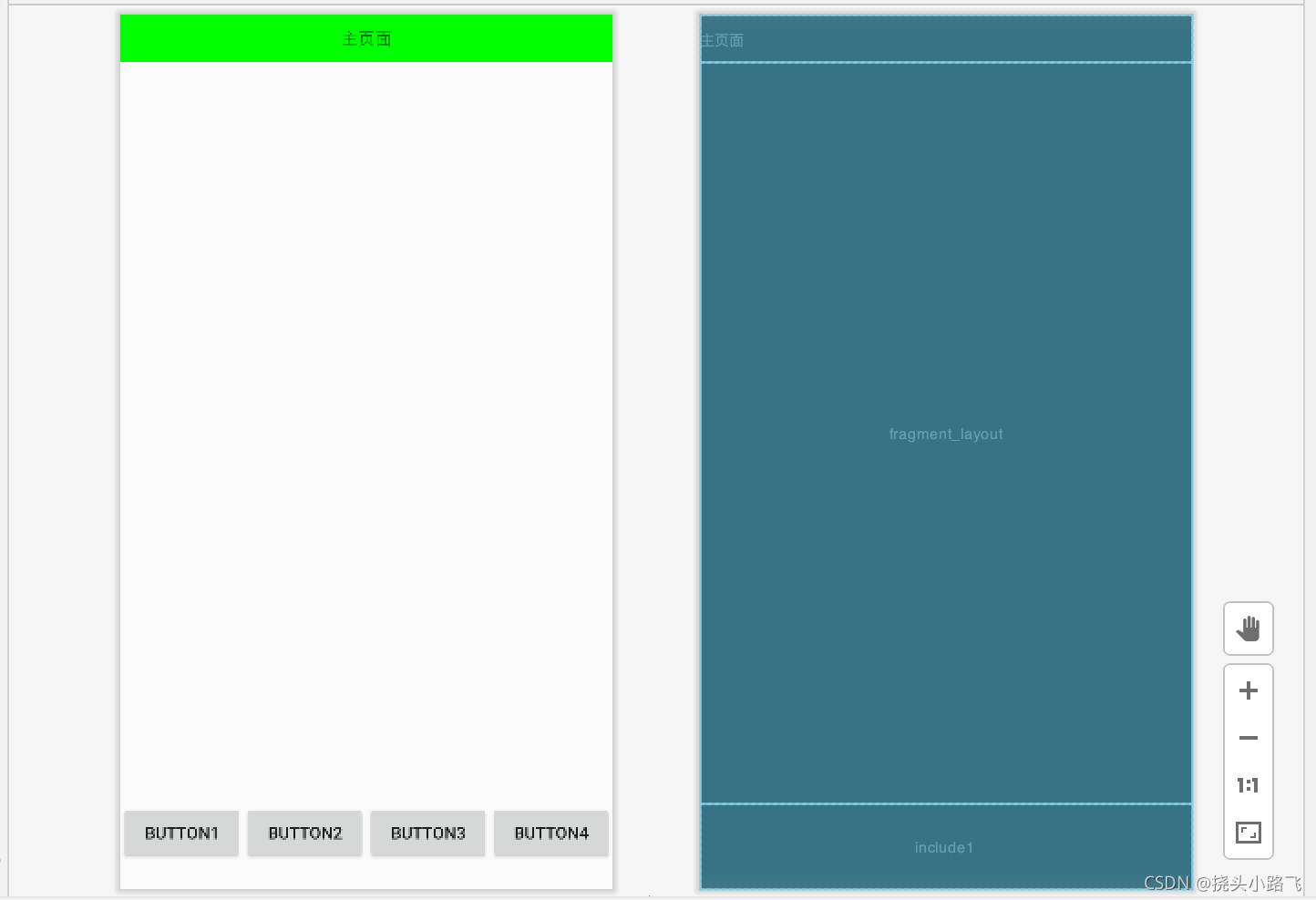
注意:include的引用,用于显示一个新的页面布局。
fragment_text_layout2.xml
fragment_text_layout2.xml
<?xml version="1.0" encoding="utf-8"?>
<LinearLayout xmlns:android="http://schemas.android.com/apk/res/android"
android:layout_width="match_parent"
android:layout_height="match_parent"
android:orientation="horizontal">
<Button
android:id="@+id/button1"
android:layout_width="0dp"
android:layout_height="wrap_content"
android:layout_weight="1"
android:text="Button1" />
<Button
android:id="@+id/button2"
android:layout_width="0dp"
android:layout_height="wrap_content"
android:layout_weight="1"
android:text="Button2" />
<Button
android:id="@+id/button3"
android:layout_width="0dp"
android:layout_height="wrap_content"
android:layout_weight="1"
android:text="Button3" />
<Button
android:id="@+id/button4"
android:layout_width="0dp"
android:layout_height="wrap_content"
android:layout_weight="1"
android:text="Button4" />
</LinearLayout>
效果: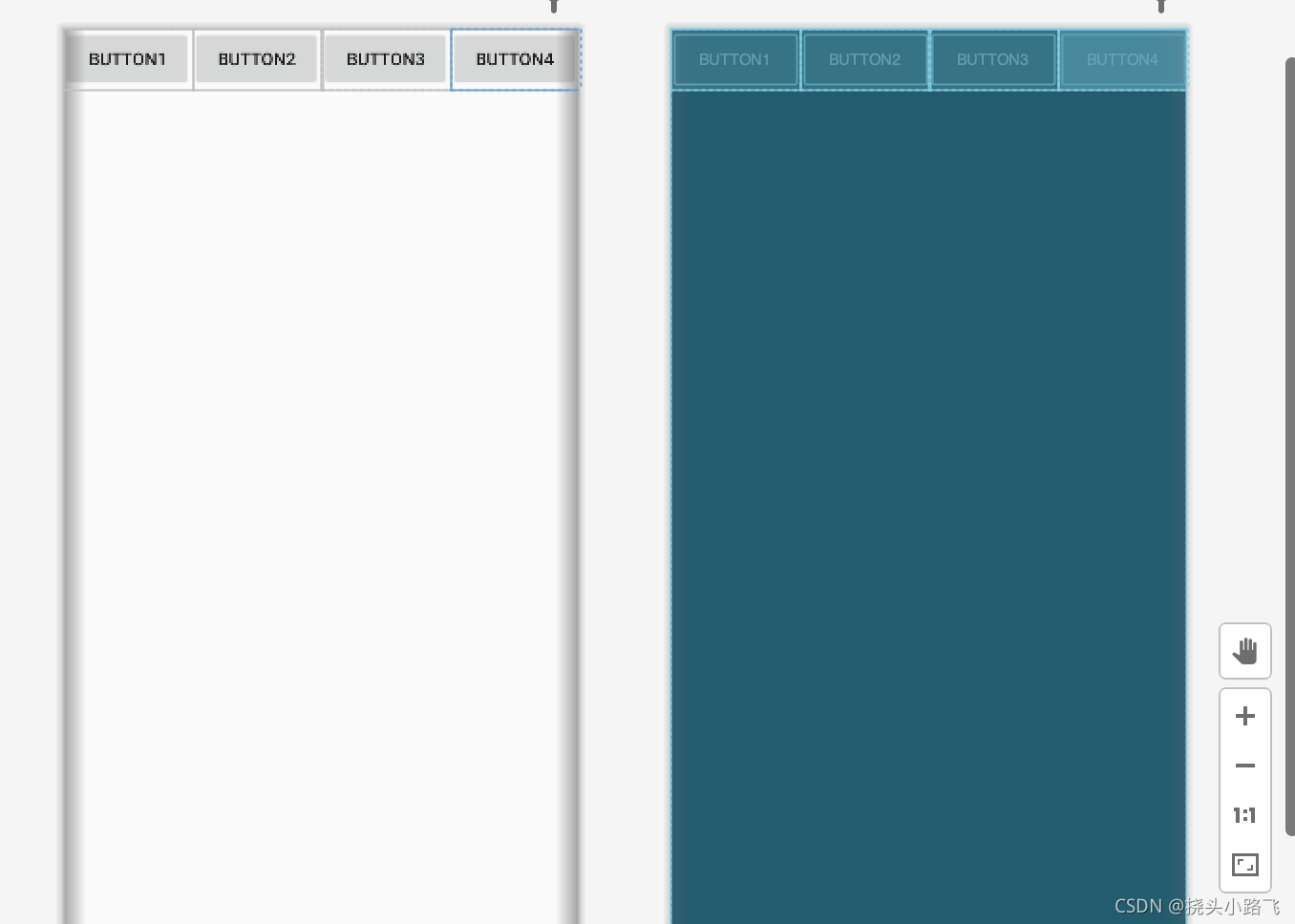
fragment_text1.java
fragment_text1.java
package com.example.myapplication_one;
import android.os.Bundle;
import android.support.annotation.NonNull;
import android.support.annotation.Nullable;
import android.support.v4.app.Fragment;
import android.view.LayoutInflater;
import android.view.View;
import android.view.ViewGroup;
public class fragment_text1 extends Fragment {
@Nullable
@Override
public View onCreateView(@NonNull LayoutInflater inflater, @Nullable ViewGroup container, @Nullable Bundle savedInstanceState) {
View view = inflater.inflate(R.layout.fragment_text_layout3,container,false);
// View view2 = inflater.inflate(R.layout.activity_list_item,null);
return view;
}
}
fragment_text_layout3.xml
fragment_text_layout3.xml
<?xml version="1.0" encoding="utf-8"?>
<LinearLayout xmlns:android="http://schemas.android.com/apk/res/android"
android:layout_width="match_parent"
android:layout_height="match_parent"
android:orientation="vertical"
android:background="#ffff00">
<TextView
android:id="@+id/textView1"
android:layout_width="wrap_content"
android:layout_height="wrap_content"
android:layout_gravity="center"
android:text="=这是第一个Fragment" />
</LinearLayout>
效果:
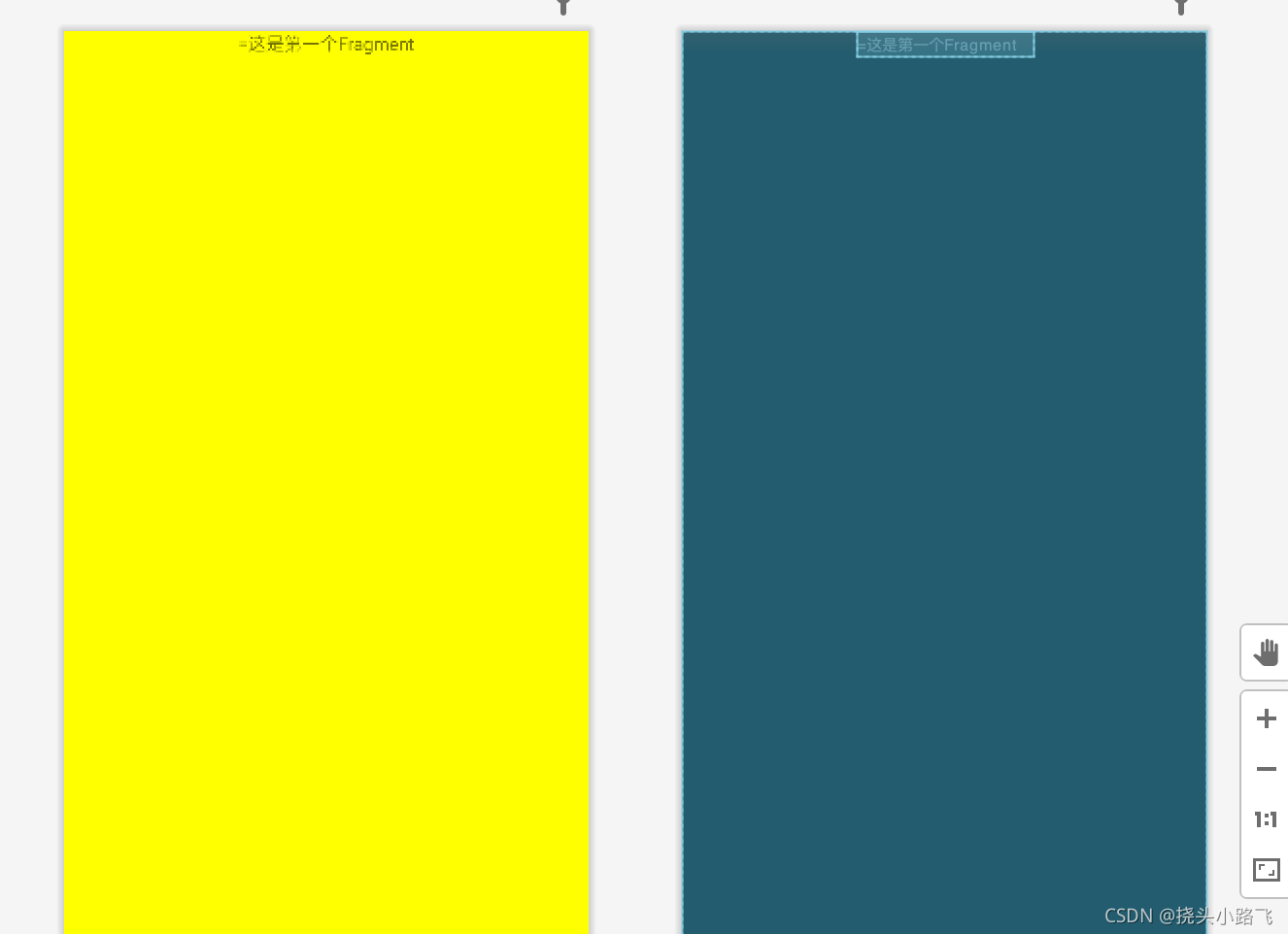
fragment_text2.java
fragment_text2.java
package com.example.myapplication_one;
import android.os.Bundle;
import android.support.annotation.NonNull;
import android.support.annotation.Nullable;
import android.support.v4.app.Fragment;
import android.view.LayoutInflater;
import android.view.View;
import android.view.ViewGroup;
public class fragment_text2 extends Fragment {
@Nullable
@Override
public View onCreateView(@NonNull LayoutInflater inflater, @Nullable ViewGroup container, @Nullable Bundle savedInstanceState) {
View view = inflater.inflate(R.layout.fragment_text_layout4,container,false);
// View view2 = inflater.inflate(R.layout.activity_list_item,null);
return view;
}
}
fragment_text_layout4.xml
fragment_text_layout4.xml
<?xml version="1.0" encoding="utf-8"?>
<LinearLayout xmlns:android="http://schemas.android.com/apk/res/android"
android:layout_width="match_parent"
android:layout_height="match_parent"
android:orientation="vertical"
android:background="#00ff00">
<TextView
android:id="@+id/textView1"
android:layout_width="wrap_content"
android:layout_height="wrap_content"
android:layout_gravity="center"
android:text="=这是第2个Fragment" />
</LinearLayout>
效果:
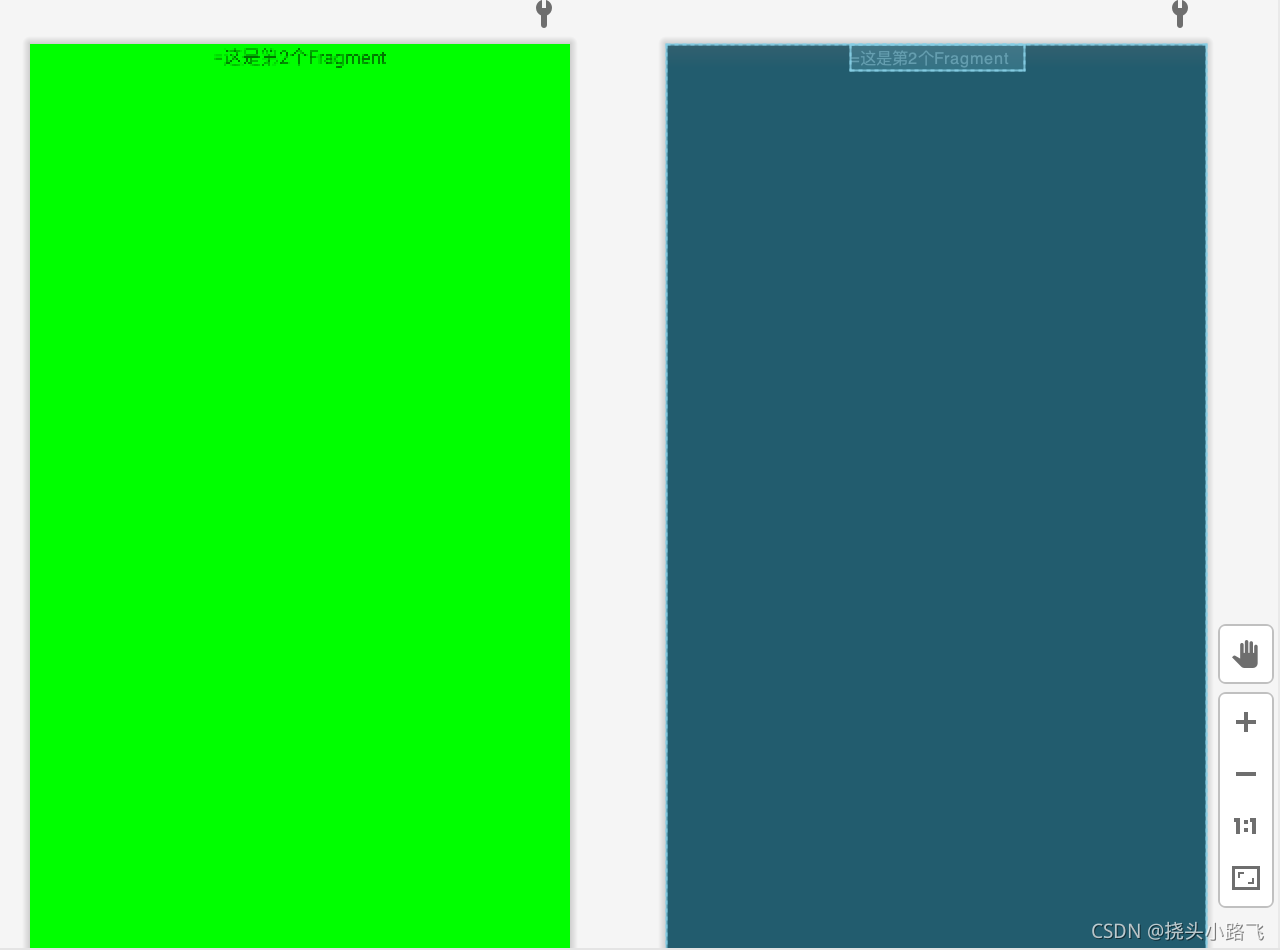
fragment_text3.java
fragment_text3.java
package com.example.myapplication_one;
import android.os.Bundle;
import android.support.annotation.NonNull;
import android.support.annotation.Nullable;
import android.support.v4.app.Fragment;
import android.view.LayoutInflater;
import android.view.View;
import android.view.ViewGroup;
public class fragment_text3 extends Fragment {
@Nullable
@Override
public View onCreateView(@NonNull LayoutInflater inflater, @Nullable ViewGroup container, @Nullable Bundle savedInstanceState) {
View view = inflater.inflate(R.layout.fragment_text_layout5,container,false);
// View view2 = inflater.inflate(R.layout.activity_list_item,null);
return view;
}
}
fragment_text_layout5.xml
fragment_text_layout5.xml
<?xml version="1.0" encoding="utf-8"?>
<LinearLayout xmlns:android="http://schemas.android.com/apk/res/android"
android:layout_width="match_parent"
android:layout_height="match_parent"
android:orientation="vertical"
android:background="#05CBE4">
<TextView
android:id="@+id/textView1"
android:layout_width="wrap_content"
android:layout_height="wrap_content"
android:layout_gravity="center"
android:text="=这是第一个Fragment" />
</LinearLayout>
效果:
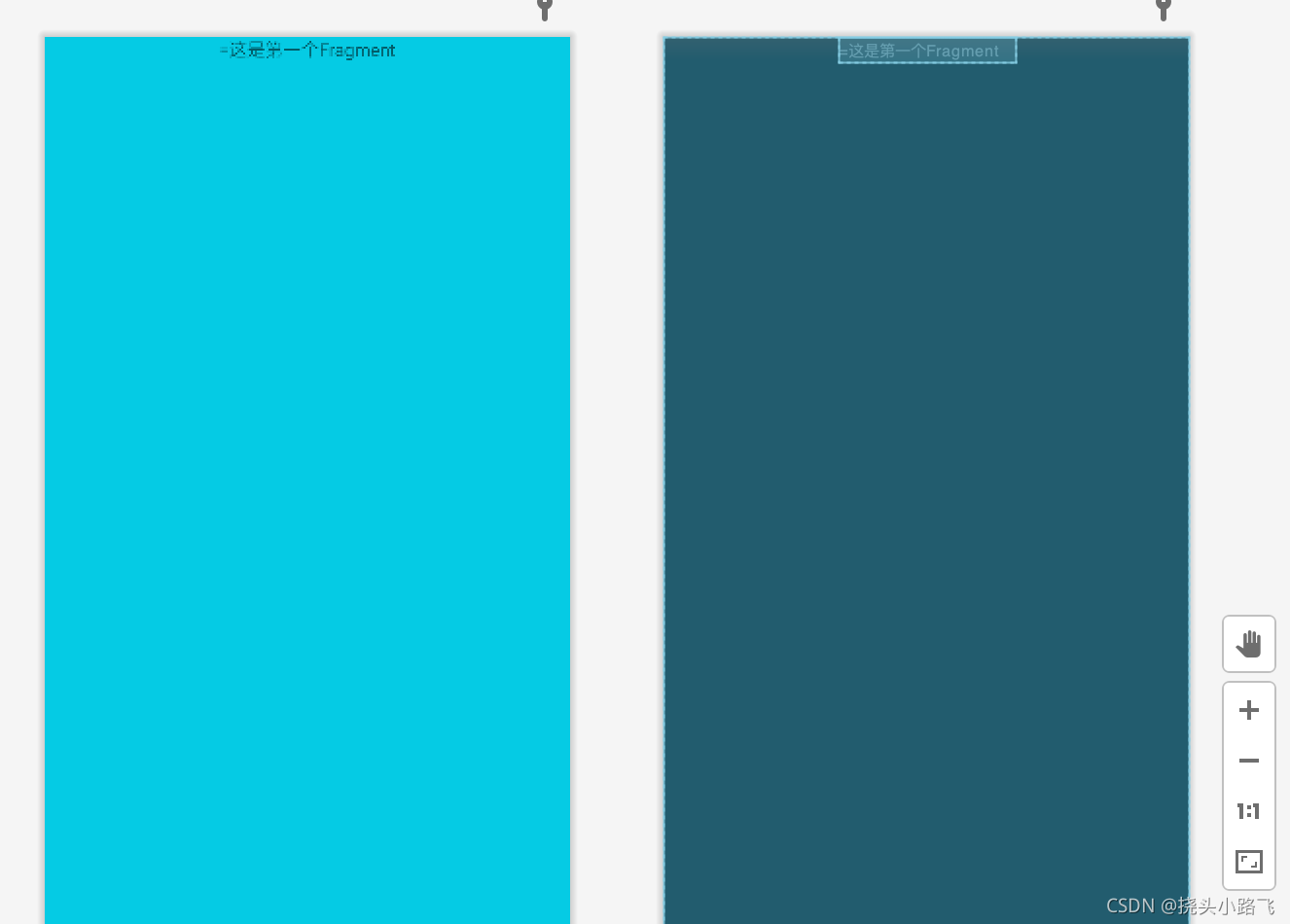
最终实现效果
更多推荐
 已为社区贡献1条内容
已为社区贡献1条内容


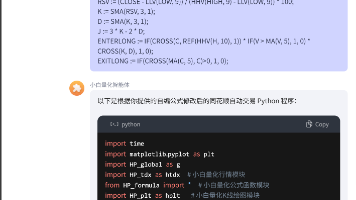






所有评论(0)